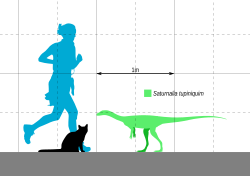Saturnalia tupiniquim
Saturnalia is an extinct genus of basal prosauropod dinosaur from the Triassic of Rio Grande do Sul, southern Brazil.[1] The deposits are dated to the early Upper Triassic, about 225 million years ago (mya). The dinosaur grew to about 1.5 meters (5 ft) long.[1]
| Saturnalia tupiniquim | |
|---|---|

| |
| Life restoration | |
| Scientific classification | |
| Kingdom: | Animalia |
| Phylum: | Chordata |
| Subfamily: | Saturnaliinae |
| Genus: | Saturnalia |
| Species: | S. tupiniquim
|
| Binomial name | |
| Saturnalia tupiniquim Langer et al., 1999
| |
Phylogeny
Saturnalia is primitive, and its mixture of characteristics,[2] has made it difficult to classify. It is one of the oldest true dinosaurs yet found.
The first (1999) description of the genus assigned it to the Sauropodomorpha.[1] However, in a 2003 paper, Langer noted that features of its skull and hand were more similar to the sister group of sauropodomorphs, the theropods. Also that Saturnalia could be a member of the sauropodomorph "stem-lineage", rather than a true member of that group.[3]
José Bonaparte and colleagues, in a 2007 study, found Saturnalia to be very similar to the primitive saurischian Guaibasaurus. Bonaparte placed the two in the same family, Guaibasauridae. Like Langer, Bonaparte found that these forms may have been primitive sauropodomorphs, or an assemblage of forms close to the common ancestor of the sauropodomorphs and theropods. Overall, Bonaparte found that both Saturnalia and Guaibasaurus were more theropod-like than prosauropod-like.[4]
However, all more recent cladistic analyses found it to be a very basal sauropodomorph,[5][6][7][8][9]
Saturnalia Tupiniquim Media
Model showing outdated quadrupedal posture, Museu Nacional, Rio de Janeiro
Size comparison of the Brazilian Triassic sauropodomorph Saturnalia. The human silhouette is from Openclipart (CC0). The cat silhouette is traced over a photograph that I took.*References* * Bronzati, M.; Rauhut, O.W.M.; Bittencourt, J.S.; Langer, M.C. (2017). "Endocast of the Late Triassic (Carnian) dinosaur Saturnalia tupiniquim: Implications for the evolution of brain tis
References
- ↑ 1.0 1.1 1.2 Langer M.C; Abdala F; Richter M. and Benton M. 1999. A sauropodomorph dinosaur from the Upper Triassic (Carnian) of southern Brazil. Comptes Rendus de l'Académie des Sciences, 329: 511-517.
- ↑ "basal sauropodomorph" and "prosauropod" mean the same thing.
- ↑ Langer M.C. 2003. The pelvic and hind limb anatomy of the stem-sauropodomorph Saturnalia tupiniquim (late Triassic, Brazil). PaleoBios, 23(2).
- ↑ Bonaparte J.F. et al 2007. A new specimen of Guaibasaurus candelariensis (basal Saurischia) from the late Triassic Caturrita Formation of southern Brazil. Historical Biology, 19(1): 73-82.
- ↑ Yates, Adam M. (2007). "The first complete skull of the Triassic dinosaur Melanorosaurus Haughton (Sauropodomorpha: Anchisauria)". In Barrett & Batten (Eds.), Evolution and Palaeobiology. 77: 9–55. ISBN 978-1-4051-6933-2.
- ↑ Pol D., Garrido A., Cerda I.A. (2011). "A new Sauropodomorph dinosaur from the early Jurassic of Patagonia and the origin and evolution of the Sauropod-type sacrum". PLOS ONE. 6 (1): e14572. Bibcode:2011PLoSO...614572P. doi:10.1371/journal.pone.0014572. PMC 3027623. PMID 21298087.
{{cite journal}}: CS1 maint: multiple names: authors list (link) - ↑ Cecilia Apaldetti, Ricardo N. Martinez, Oscar A. Alcober and Diego Pol (2011). "A new basal Sauropodomorph (Dinosauria: Saurischia) from Quebrada del Barro Formation (Marayes-El Carrizal Basin), Northwestern Argentina". PLOS ONE. 6 (11): e26964. Bibcode:2011PLoSO...626964A. doi:10.1371/journal.pone.0026964. PMC 3212523. PMID 22096511.
{{cite journal}}: CS1 maint: uses authors parameter (link) - ↑ Ezcurra M. D. (2010). "A new early dinosaur (Saurischia: Sauropodomorpha) from the late Triassic of Argentina: a reassessment of dinosaur origin and phylogeny". Journal of Systematic Palaeontology. 8 (3): 371–425. doi:10.1080/14772019.2010.484650. S2CID 129244872.
- ↑ Novas, Fernando E.; et al. (2011). "New dinosaur species from the Upper Triassic Upper Maleri and Lower Dharmaram formations of central India". Earth and Environmental Science Transactions of the Royal Society of Edinburgh. 101 (3–4): 333–349. doi:10.1017/S1755691011020093. S2CID 128620874.


